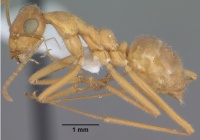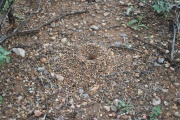Myrmecocystus mexicanus
| Myrmecocystus mexicanus | |
|---|---|
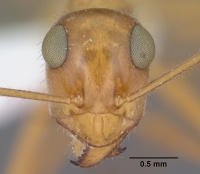
| |
| Scientific classification | |
| Kingdom: | Animalia |
| Phylum: | Arthropoda |
| Class: | Insecta |
| Order: | Hymenoptera |
| Family: | Formicidae |
| Subfamily: | Formicinae |
| Tribe: | Lasiini |
| Genus: | Myrmecocystus |
| Subgenus: | Myrmecocystus |
| Species group: | mexicanus |
| Species: | M. mexicanus |
| Binomial name | |
| Myrmecocystus mexicanus Wesmael, 1838 | |
| Synonyms | |
| |
The most well studied Myrmecocystus species. They are nocturnal foragers that gather a variety of exudates and, although not a major part of their diet, also scavenge dead insects.
| At a Glance | • Replete Workers |
Photo Gallery
Identification
A member of the mexicanus group of the Myrmecoystus subgenus Myrmecocystus .
Key to Myrmecocystus subgenus Myrmecocystus species.
Worker - Propodeal dorsum evenly convex, abundantly hairy; metanotal suture usually distinctly impressed; HL usually in excess of 1.3 mm; eye with few or no erect hairs, when hairs present, less than 0.017 mm long. Female - Penultimate segment of maxillary palp broadest basally; hind tibia with abundant fully erect hairs; HW more than 2.0 mm. Male - Scape and tibia with conspicuous erect hairs; occipital hairs shorter than maximum diameter of lateral ocellus; apical margin of forewing with vestiges of fringe; HW more than 0.9 mm. (Snelling 1976)
Mackay and Mackay (2002) - This is a pale yellow ant with black eyes. The head length of the largest workers exceeds 1.3 mm, the eyes have few or no short, erect hairs, the propodeal dorsum is evenly convex and abundantly hairy and the metanotal suture is usually distinctly impressed. This species can be easily confused with Myrmecocystus navajo.
Keys including this Species
Distribution
United States, Mexico. Central Mexico north to Colorado and Utah, westward to California and Lower California.
Latitudinal Distribution Pattern
Latitudinal Range: 42.946° to 18.3333°.
| North Temperate |
North Subtropical |
Tropical | South Subtropical |
South Temperate |
- Source: AntMaps
Distribution based on Regional Taxon Lists
Nearctic Region: United States.
Neotropical Region: Mexico (type locality).
Distribution based on AntMaps
Distribution based on AntWeb specimens
Check data from AntWeb
Countries Occupied
| Number of countries occupied by this species based on AntWiki Regional Taxon Lists. In general, fewer countries occupied indicates a narrower range, while more countries indicates a more widespread species. |

|
Habitat
Snelling (1976) - This is a species of the Sonoran and Transition Zones, with most records from areas in the Sonoran. Within the Sonoran Zones, it appears to be about equally abundant in Lower and Upper Sonoran habitats. In Colorado, Gregg (1963) recorded this species (as mexicanus hortideorum) from Pinon-Juniper Woodland, Pinon-Cedar-Oak Woodland, Sagebrush Desert, Sagebrush-Greasewood Desert and Saltbush Desert. The elevational amplitude in Colorado was noted to be a little over two thousand feet, but Gregg correctly noted that over the entire range of the species it would be much greater. In southern California, the lowest elevation is below sea level (-225 feet) at Salton Sea Beach and the highest is 5185 feet above sea level at Salton View in Joshua Tree National Monument, less than 45 miles to the north. The greatest elevation record is 8000 feet, 6 mi NE Santa Fe, New Mexico.
In New Mexico (Mackay and Mackay 2002) – Occurs in typical creosotebush desert scrub, sagebrush, oak woodland up to pinyon-juniper. This is one of the most common species of Myrmecocystus in New Mexico.
Biology
This is the most extensively studied of all the species of Myrmecocystus. McCook (1881, 1882) published the results of his studies in Colorado; these were supplemented by Wheeler (1908). Briefly, the species forages at night, less commonly on cool, overcast days. Workers emerge singly and seek out food items. The ants derive much of their sustenance from exudates from galls on oaks (Quercus spp.) as well as from aphids and pseudococcids (Homoptera). They also take juices from bruised or broken fruits which may be available, such as those of cacti (Opuntia spp.) and nectar from a wide variety of flowers and from extrafloral glands.
The ants are by no means wholly dependent upon nectar and fruit juices, for they are assiduous general scavengers. In general, however, this species seems not to be an active predator. I have rarely observed it attacking live insects. On those occasions when I have made such observations, workers were picking up insects attracted to lights at night. Foragers would rush up to an insect and grasp it with the mandibles. If the prey was much smaller than the ant it was immediately carried away. If of a size approximately equal to that of the ant and struggled, it was released and the ant would dart away.
Most protein material brought to the nest consists of fragments of already dead, often desiccated arthropods. Colonies observed in southern Arizona regularly picked up head capsules of Pogonomyrmex spp. from detritus piles around the nests of the harvester ants.
Foraging is an individual matter for the most part. The usual pattern seems to consist of an initial mass exodus of workers at the onset of the foraging period. The workers quickly radiate in all directions. Obviously, if there are previously visited sources of food in a limited area, such as a plant harboring large numbers of aphids, a sizable percentage of the foragers ultimately arrive there, but there are no foraging "trails" as such.
Flight activities of the sexual forms are not well documented and most of the available reproductive have been removed from nests. The mating flights occur during summer or fall rainy seasons, apparently in late afternoon or early evening following an afternoon rain.
Cole et al. (2001) - We examined the spatial pattern of the ant Myrmecocystus mexicanus and although intraspecific dispersion is highly uniform, colonies were significantly associated with reproductively mature nests of the harvester ant Pogonomyrmex occidentalis. Colonies of M. mexicanus were more likely to be found within 3m of P. occidentalis and less likely to be found as far as 10m away. The protein component of the diet of M. mexicanus is almost exclusively dead or moribund workers of P. occidentalis. M. mexicanus appears to associate with one of its consistent food sources.
Nesting Habits
McCook (1882), Wheeler (1908) and Gregg (1963) have noted that the tumulus marking the entrance of the nest is crateriform and is constructed of coarse gravel and pebbles. Occasionally, nests may be situated in fine, deep sand, in which case the tumulus consists of much finer particles, though even then the coarsest particles available are used. Nests of this species seem always to have but a single entrance which may be as much as 2.3 cm diameter at the surface.
- Nest Mounds
Gordon Snelling has observed large nests, 5 inches in diameter, in southern California.
Association with Other Organisms
 Explore: Show all Associate data or Search these data. See also a list of all data tables or learn how data is managed.
Explore: Show all Associate data or Search these data. See also a list of all data tables or learn how data is managed.
- This species is a associate (details unknown) for the eulophid wasp Tetrastichus sp. (a associate (details unknown)) (Quevillon, 2018).
Flight Period
| X | X | ||||||||||
| Jan | Feb | Mar | Apr | May | Jun | Jul | Aug | Sep | Oct | Nov | Dec |
Source: antkeeping.info.
- Check details at Worldwide Ant Nuptial Flights Data, AntNupTracker and AntKeeping.
 Explore: Show all Flight Month data or Search these data. See also a list of all data tables or learn how data is managed.
Explore: Show all Flight Month data or Search these data. See also a list of all data tables or learn how data is managed.
Castes
Worker
 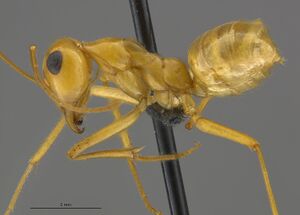  
| |
| . | Owned by Museum of Comparative Zoology. |
Images from AntWeb
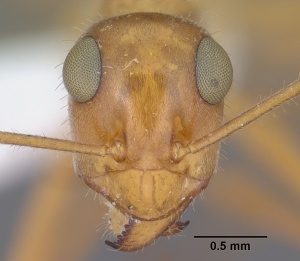   
| |
| Worker. Specimen code casent0102814. Photographer Jen Fogarty, uploaded by California Academy of Sciences. | Owned by CAS, San Francisco, CA, USA. |
   
| |
| Worker. Specimen code casent0005421. Photographer April Nobile, uploaded by California Academy of Sciences. | Owned by UCDC, Davis, CA, USA. |
Nomenclature
The following information is derived from Barry Bolton's Online Catalogue of the Ants of the World.
- mexicanus. Myrmecocystus mexicanus Wesmael, 1838: 770 (w.) MEXICO. Wheeler, G.C. & Wheeler, J. 1968: 213 (l.). Junior synonym of melliger: Forel, 1886f: 201; Mayr, 1886d: 424. Revived from synonymy: Wheeler, W.M. 1908d: 356. Senior synonym of hortusdeorum: Snelling, R.R. 1976: 120.
- hortusdeorum. Myrmecocystus melliger var. hortusdeorum McCook, 1881b: 69, pl. 7, figs. 37-39, 47, 48, 50; pl. 10, figs. 72, 73, 75-81 (w.q.m.) U.S.A. Forel, 1886f: 202 (q.m.). Raised to species: Forel, 1886f: 202. Subspecies of mexicanus: Emery, 1893i: 666; Creighton, 1950a: 446. Junior synonym of mexicanus: Snelling, R.R. 1976: 120.
Unless otherwise noted the text for the remainder of this section is reported from the publication that includes the original description.
Snelling (1976) - The traditional interpretation of Myrmecocystus mexicanus, and that which is continued here, is probably not correct. I believe Wesmael's specimens most likely belonged to the species here called Myrmecocystus melanoticus. Since the lack of authentic mexicanus renders this assumption beyond proof, it seems least disruptive to continue established usage.
The northern populations, extending from Colorado to the Pacific Coast have usually been recognized as a more uniformly yellowish subspecies. I have here synonymized that "subspecies" because I do not believe its continued recognition is defensible. One reason for so doing is based on the broadly clinal nature of the color pattern; because of the existence of such a pattern, it is not possible to define the color forms in such a way as would permit their recognition. An attempt to continue recognition of these color forms results in about one-half the material being impossible of assignment.
More important, however, is the fact that the populations of the "subspecies" hortideorum are not equivalent to one another. Workers from Colorado and Utah are, as a rule, more densely hairy than some from California and Lower California. Workers from many western populations have about 16 erect and suberect hairs per 0.50 mm of scape length, a condition about the same as in specimens from Colorado. Specimens in other samples have about half that number. In some areas, such as Pearblossom, Los Angeles Co., Calif., the inhabitants of adjacent nests may differ widely in this regard.
Males from California and Lower California usually possess fringe hairs along the apical margin of the forewing. Those from Colorado do not, a trait which they share with those of "typical" mexicanus from southern New Mexico and Arizona and central Mexico. Fringe hairs are wholly lacking from both fore and hind wings in males collected at Cajon Canyon, California. In this regard these males are more like the eastern males of this species. The petiole, however, is not as in the males from Colorado.
Normally the petiole in Colorado males, in profile, is cuneate and sharply crested. Those from California are inconsistent and while it may be as sharply cuneate as in the Colorado males, the petiole is often broadly rounded in profile, but males from any single locality seem to be extremely variable in this character. The few males available from central Mexico consistently possess a broadly rounded petiolar node.
Description
Worker
Snelling (1976) - Measurements. HL 1.00-2.17 (1.80); HW 0.70-2.03 (1.40); SL 1.30-2.70 (2.20); WL 1.6-3.8 (2.9); PW 0.55-1.30 (1.1).
Head: Longer than broad in all sizes, CI 70-94 (78), much shorter than scape, SI 114-149 (122). In frontal view, malar margins straight and subparallel in small workers, in largest workers widest at level of antennal sockets, convergent toward mandibular insertions below; occipital margin flat or slightly convex, usually well above top of eye, sometimes barely so in smallest workers. Eye large, 1.09-1.20 (1.14) x length of first flagellomere; OMD 1.09-1.72 (1.37) x EL. Mandible usually with nine teeth, but commonly with ten, rarely with eight; space between basal and subbasal teeth not exceeding size of basal tooth.
Thorax: Slender, PW 0.30-0.37 (0.36) x WL. Basal face of propodeum gently to strongly convex, broadly rounded into posterior face. Metanotal depression sometimes weak in largest workers, but usually well defined.
Petiole: In profile, robust cuneiform, with rounded crest; crest, in frontal view, weakly or not at all notched.
Vestiture: Dorsa of head, thorax and gaster with abundant fully appressed pubescence, well separated on head and thorax, denser on propodeum and first three terga.
Head with numerous erect hairs, malar area with ten or more erect hairs; longest cephalic hairs less than 0.17 mm long in largest workers, except beneath and along clypeal margin; eye with very sparse, very short (less than 0.017 mm long) hairs, or none. Erect hairs on thoracic dorsum evenly distributed, longest (up to 0.20 mm in largest workers) on pronotum, shortest (about 1/3 length of longest pronotal hairs) on metanotum and propodeum. Petiolar node with numerous short, erect hairs. Terga with abundant erect hairs, progressively longer on succeeding segments, sparser and longer on sterna. Appendages with abundant erect hairs, including inner and lower surfaces of fore femur.
Integument: Front of head moderately shiny, with well separated micropunctures and scattered coarse, shallow punctures, micropunctures coarsest on frontal lobes. Clypeus shinier than frons, lightly shagreened, with sparse coarse punctures, with ill-defined median impunctate line. Integument otherwise lightly to moderately shagreened, moderately shiny.
Color: Highly variable, from wholly pale yellowish to light yellowish-brown with gaster darker.
Queen
Snelling (1976) - Measurements. HL 1.90-2.50; HW 1.90-2.55; SL 1.85-2.50; EL 0.60-0.80; OMD 0.66-0.90; WL 4.2-5.6; PW 2.35-3.15.
Head: Slightly longer than broad to slightly broader than long, CI 91-108; a little shorter than to a little longer than scape, SI 89-109. Head broadest at level of lower eye margin, sides in frontal view straight or slightly convex, evenly narrowed toward mandibular insertions; occiput slightly convex in frontal view, broadly rounded at sides. Eye large, about 1.3 x first flagellomere; OMD 1.07-1.28 x EL; OOD 2.3-3.6 x OD; IOD 1.6-2.4 x OD. Mandible with nine or ten teeth. Penultimate segment of maxillary palp broadest a little before middle, slightly narrowed toward base, more strongly narrowed toward apex.
Thorax: Robust, PW 0.53-0.61 x WL. In profile, scutum flattened behind, scutellum convex, not in line with posterior part of scutum.
Petiole: In profile, compressed-cuneate; crest sharply notched in frontal view; from above, about twice wider than long.
Vestiture: Cephalic pilosity about as described for worker. Mesoscutum and scutellum with scattered, long (up to 0.23 mm) erect hairs arising from coarse punctures; pleura with scattered long erect hairs; propodeum with a few short (up to 0.10 mm) erect hairs on upper third. Petiolar scale with numerous erect hairs. Discs of terga with abundant stiff erect hairs, progressively longer on succeeding segments; sterna with hairs longer, more numerous on apical half; appendages, including inner and lower surfaces of fore femur, with abundant erect and suberect hairs of moderate length. Wings without fringe hairs on apical or posterior margins.
Pubescence general, nowhere concealing surface.
Integument: Clypeus shiny, coarsely punctate, punctures elongate, of varying size; frontal lobes, frons and occiput moderately shiny, closely micropunctate. Malar area duller, coriaceous, closely punctate, punctures elongate.
Pronotum moderately shiny, micropunctate, with scattered coarser punctures. Disc of mesoscutum densely, finely punctate, with scattered coarser punctures; parapsis similar, but with coarser punctures a little more numerous. Scutellum polished between fine, dense punctures. Pleura shinier, more sparsely punctate above, punctures fine. Propodeum slightly shiny, shagreened, with fine, dense punctures. First three terga shiny, densely and finely punctate.
Color: Yellowish to yellowish ferruginous, with variable brownish infuscations on occiput, thoracic dorsum and abdominal terga. Wings yellowish hyaline, veins and stigma ferruginous to light brownish.
Male
Snelling (1976) - Measurements. HL 0.90-1.23; HW 0.73-1.17; SL 1.07-1.53; EL 0.37-0.50; OMD 0.20-0.27; WL 2.05-3.10; PW 1.00-1.47.
Head: Longer than broad, CI 83-95; in frontal view, sides straight or slightly concave, convergent toward mandibular insertions; distinctly shorter than scape, SI 116-130; occiput, in frontal view evenly convex, without lateral angles. Eye large; OMD 0.50-0.67 x EL; OOD 1.07-1.53 x OD. IOD 2.05-3.10 x OD. Mandible with one or more preapical teeth.
Thorax: Robust, PW 0.45-0.53 x WL. Propodeum with distinct basal and posterior faces.
Petiole: In profile, cuneate and sharp-crested to broadly rounded above; in frontal view, crest with more or less distinct angular notch.
Vestiture: Erect hairs sparse on head and thorax; those of occiput short (up to 0.10 mm), much shorter than MOD; a few longer (up to 0.16 mm) on malar area. Scutal hairs about equal to those of occiput, longer (up to 0.16 mm) on scutellum; hairs very sparse on pleura, little, if any, longer than on scutum. Propodeum commonly without erect hairs except near valvule, but a few very short hairs may be present on basal face. Petiolar node with sparse, short erect hairs. Terga with sparse, fully erect hairs, up to 0.10 mm on disc of second segment; sterna with hairs more numerous, longer, up to 0.23 mm on second segment. Appendages with sparse to abundant erect and suberect short hairs; forewing with or without apical fringe hairs; hind wing with or without fringe hairs along apical and posterior margins.
Pubescence general but sparse, densest on occiput, propodeum and first three terga.
Integument: Head moderately shiny, lightly coriaceous, without conspicuous punctation. Mesoscutum moderately shiny, with dense micropunctures and scattered coarse punctures; scutellum shinier, punctures less distinct than on scutum; pleura moderately shiny, with scattered coarse punctures. Terga moderately shiny, with abundant micropunctures on discs.
Color: Yellowish, often with brownish infuscation of varying extent on dorsa of head and thorax, gaster often largely brownish. Wings whitish hyaline to slightly brownish, veins and stigma whitish to yellowish.
Type Material
Snelling (1976) - Wesmael's specimens were from an unknown locality in Mexico; no types were ever designated and no original material is known to exist. McCook's hortus-deorum material came from the Garden of the Gods, near Colorado Springs, Colorado. No original material is known to exist. Neotype worker and 31 neoparatype workers, here designated: MEXICO, State of Chihuahua: 21 mi SW Jimenez, 23 Dec. 1958 (A. S. Menke & L. A. Stange). Neotype and neoparatypes in Los Angeles County Museum of Natural History; two neoparatypes each in American Museum of Natural History, Museum of Comparative Zoology, and National Museum of Natural History.
References
- Alatorre-Bracamontes, C.E., Vásquez-Bolaños, M. 2010. Lista comentada de las hormigas (Hymenoptera: Formicidae) del norte de México. Dugesiana 17(1): 9-36.
- Boudinot, B.E., Borowiec, M.L., Prebus, M.M. 2022. Phylogeny, evolution, and classification of the ant genus Lasius, the tribe Lasiini and the subfamily Formicinae (Hymenoptera: Formicidae). Systematic Entomology 47, 113-151 (doi:10.1111/syen.12522).
- Cantone S. 2018. Winged Ants, The queen. Dichotomous key to genera of winged female ants in the World. The Wings of Ants: morphological and systematic relationships (self-published).
- Cole, B.J., Haight, K., Wiernasz, D.C. 2001. Distribution of Myrmecocystus mexicanus (Hymenoptera: Formicidae): Association with Pogonomyrmex occidentalis (Hymenoptera: Formicidae). Annals of the Entomological Society of America 94: 59-63 (doi:10.1603/0013-8746(2001)094[0059:DOMMHF2.0.CO;2]).
- Forel, A. 1886h. Études myrmécologiques en 1886. Ann. Soc. Entomol. Belg. 30: 131-215 (page 201, Junior synonym of melliger)
- Hoey-Chamberlain, R.V. 2012. Food preference, survivorship, and intraspecific interactions of Velvety Tree Ants. M.S. thesis, University of California, Riverside.
- Mackay, W. P. and E. Mackay. 2002. The ants of New Mexico (Hymenoptera: Formicidae). Edwin Mellen Press, Lewiston, NY.
- Mayr, G. 1886d. Die Formiciden der Vereinigten Staaten von Nordamerika. Verh. K-K. Zool.-Bot. Ges. Wien 36: 419-464 (page 424, Junior synonym of melliger)
- Meurville, M.-P., LeBoeuf, A.C. 2021. Trophallaxis: the functions and evolution of social fluid exchange in ant colonies (Hymenoptera: Formicidae). Myrmecological News 31: 1-30 (doi:10.25849/MYRMECOL.NEWS_031:001).
- Snelling, R. R. 1976. A revision of the honey ants, genus Myrmecocystus (Hymenoptera: Formicidae). Nat. Hist. Mus. Los Angel. Cty. Sci. Bull. 24: 1-163 (page 120, Senior synonym of hortusdeorum)
- van Elst, T., Eriksson, T.H., Gadau, J., Johnson, R.A., Rabeling, C., Taylor, J.E., Borowiec, M.L. 2021. Comprehensive phylogeny of Myrmecocystus honey ants highlights cryptic diversity and infers evolution during aridification of the American Southwest. Molecular Phylogenetics and Evolution 155, 107036 (doi:10.1016/j.ympev.2020.107036).
- Wesmael, C. 1838. Sur une nouvelle espèce de fourmi du Mexique. Bull. Acad. R. Sci. B.-Lett. Brux. 5: 766-771 (page 770, worker described)
- Wheeler, G. C.; Wheeler, J. 1968a. The ant larvae of the subfamily Formicinae (Hymenoptera: Formicidae): supplement. Ann. Entomol. Soc. Am. 61: 205-222 (page 213, larva described)
- Wheeler, W. M. 1908g. Honey ants, with a revision of the American Myrmecocysti. Bull. Am. Mus. Nat. Hist. 24: 345-397 (page 356, Revived from synonymy)
References based on Global Ant Biodiversity Informatics
- Alatorre-Bracamontes, C.E. and M Vasquez-Bolanos. 2010. Lista comentada de las hormigas (Hymenoptera: Formicidae) del norte de México. Dugesiana 17(1):9-36
- Allred D. M. 1982. Ants of Utah. The Great Basin Naturalist 42: 415-511.
- Allred, D.M. 1982. The ants of Utah. Great Basin Naturalist 42:415-511.
- Andersen A. N. 1997. Functional Groups and Patterns of Organization in North American Ant Communities: A Comparison with Australia. Journal of Biogeography. 24: 433-460
- Beck D. E., D. M. Allred, W. J. Despain. 1967. Predaceous-scavenger ants in Utah. Great Basin Naturalist 27: 67-78
- Bestelmeyer B. T., and J. A. Wiens. 2001. Local and regional-scale responses of ant diversity to a semiarid biome transition. Ecography 24: 381-392.
- Cokendolpher J. C., and O. F. Francke. 1990. The ants (Hymenoptera, Formicidae) of western Texas. Part II. Subfamilies Ecitoninae, Ponerinae, Pseudomyrmecinae, Dolichoderinae, and Formicinae. Special Publications, the Museum. Texas Tech University 30:1-76.
- Cole A. C., Jr. 1934. An annotated list of the ants of the Snake River Plains, Idaho (Hymenoptera: Formicidae). Psyche (Cambridge) 41: 221-227.
- Cole A. C., Jr. 1942. The ants of Utah. American Midland Naturalist 28: 358-388.
- Cole, A.C. 1936. An annotated list of the ants of Idaho (Hymenoptera; Formicidae). Canadian Entomologist 68(2):34-39
- Coronado-Blanco J. M., D. A. Dubovikoff, E. Ruiz-Cancino, M. Vasquez-Bolanos, K. Y. Flores-Maldonado, and J. V. Horta-Vega. 2013. Formicidae (Hymenoptera) del estado de Tamaulipas, Mexico. CienciaUat 25(1): 12-17.
- Cover S. P., and R. A. Johnson. 20011. Checklist of Arizona Ants. Downloaded on January 7th at http://www.asu.edu/clas/sirgtools/AZants-2011%20updatev2.pdf
- Dattilo W. et al. 2019. MEXICO ANTS: incidence and abundance along the Nearctic-Neotropical interface. Ecology https://doi.org/10.1002/ecy.2944
- Des Lauriers J., and D. Ikeda. 2017. The ants (Hymenoptera: Formicidae) of the San Gabriel Mountains of Southern California, USA with an annotated list. In: Reynolds R. E. (Ed.) Desert Studies Symposium. California State University Desert Studies Consortium, 342 pp. Pages 264-277.
- Fernandes, P.R. XXXX. Los hormigas del suelo en Mexico: Diversidad, distribucion e importancia (Hymenoptera: Formicidae).
- Gregg, R.T. 1963. The Ants of Colorado.
- Johnson R. Personnal Database. Accessed on February 5th 2014 at http://www.asu.edu/clas/sirgtools/resources.htm
- Johnson, R.A. and P.S. Ward. 2002. Biogeography and endemism of ants (Hymenoptera: Formicidae) in Baja California, Mexico: a first overview. Journal of Biogeography 29:10091026/
- La Rivers I. 1968. A first listing of the ants of Nevada. Biological Society of Nevada, Occasional Papers 17: 1-12.
- MacKay W. P. 1993. Succession of ant species (Hymenoptera: Formicidae) on low-level nuclear waste sites in northern New Mexico. Sociobiology 23: 1-11.
- Mackay W. P., and E. E. Mackay. 2002. The ants of New Mexico (Hymenoptera: Formicidae). Lewiston, New York: Edwin Mellen Press, 400 pp.
- Mackay, W., D. Lowrie, A. Fisher, E. Mackay, F. Barnes and D. Lowrie. 1988. The ants of Los Alamos County, New Mexico (Hymenoptera: Formicidae). pages 79-131 in J.C. Trager, editor, Advances in Myrmecololgy.
- Mallis A. 1941. A list of the ants of California with notes on their habits and distribution. Bulletin of the Southern California Academy of Sciences 40: 61-100.
- Michigan State University, The Albert J. Cook Arthropod Research Collection. Accessed on January 7th 2014 at http://www.arc.ent.msu.edu:8080/collection/index.jsp
- Nash M. S., W. G. Whitford, J. Van Zee, and K. M. Havstad. 2000. Ant (Hymenoptera: Formicidae) responses to environmental stressors in the Northern Chihuahuan Desert. Environ. Entomol, 29(2): 200-206.
- O'Keefe S. T., J. L. Cook, T. Dudek, D. F. Wunneburger, M. D. Guzman, R. N. Coulson, and S. B. Vinson. 2000. The Distribution of Texas Ants. The Southwestern Entomologist 22: 1-92.
- Snelling R. R. 1976. A revision of the honey ants, genus Myrmecocystus (Hymenoptera: Formicidae). Natural History Museum of Los Angeles County. Science Bulletin 24: 1-163
- Snelling, R.R. 1982. A revision of the honey ants, genus Myrmecocystus, first supplement (Hymenoptera: Formicidae) Bulletin of the Southern California Academy of Sciences 81(2):69-86
- Vasquez-Bolanos M. 2011. Checklist of the ants (Hymenoptera: Formicidae) from Mexico. Dugesiana 18(1): 95-133.
- Vásquez-Bolaños M. 2011. Lista de especies de hormigas (Hymenoptera: Formicidae) para México. Dugesiana 18: 95-133
- Wheeler G. C. and Wheeler J. 1973. Ants of Deep Canyon. Riverside, Calif.: University of California, xiii + 162 pp
- Wheeler W. M. 1908. Honey ants, with a revision of the American Myrmecocysti. Bulletin of the American Museum of Natural History 24: 345-397.
- Wheeler W. M. 1912. Additions to our knowledge of the ants of the genus Myrmecocystus Wesmael. Psyche (Cambridge) 19: 172-181.
- Wheeler, G.C. and J. Wheeler. 1985. A checklist of Texas ants. Prairie Naturalist 17:49-64.
- Whitford W. G. 1978. Structure and seasonal activity of Chihuahua desert ant communities. Insectes Sociaux 25(1): 79-88.
- Whitford W.G., Zee J.V., Nash M.S., Smith W.E. and Herrick J.E. 1999. Ants as Indicators of Exposure to Environmental Stressors in North American Desert Grasslands. Environmental Monitoring and Assesment. 54:
- Pages using DynamicPageList3 parser function
- Replete Workers
- Photo Gallery
- North temperate
- North subtropical
- Tropical
- Nesting Notes
- Eulophid wasp Associate
- Host of Tetrastichus sp.
- FlightMonth
- Species
- Extant species
- Formicidae
- Formicinae
- Lasiini
- Myrmecocystus
- Myrmecocystus mexicanus
- Formicinae species
- Lasiini species
- Myrmecocystus species
- Ssr
